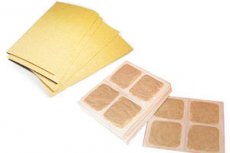Medical expert of the article
New publications
How and where to put mustard therapy for osteochondrosis?
Last reviewed: 04.07.2025

All iLive content is medically reviewed or fact checked to ensure as much factual accuracy as possible.
We have strict sourcing guidelines and only link to reputable media sites, academic research institutions and, whenever possible, medically peer reviewed studies. Note that the numbers in parentheses ([1], [2], etc.) are clickable links to these studies.
If you feel that any of our content is inaccurate, out-of-date, or otherwise questionable, please select it and press Ctrl + Enter.

Usually, pains accompanying such pathology of intervertebral discs as osteochondrosis are relieved with ointments. But can mustard plasters be used instead of ointments for osteochondrosis? It turns out that it is possible and necessary.
 [ 1 ]
[ 1 ]
Indications
Indications for treatment of this disease of the musculoskeletal system and connective tissue with mustard plasters are due to the fact that osteochondrosis is a dorsopathic disease, that is, a degenerative-dystrophic disease.
Osteochondrosis develops due to a disruption in the trophism of the cartilaginous tissue of the intervertebral discs, and pain (essentially neuralgic) occurs as a result of the gradual destruction of the discs, which begin to compress nearby nerve fibers and pinch the nerve roots.
With osteochondrosis, there is no inflammatory process, and the use of non-steroidal anti-inflammatory drugs and ointments only relieves pain, but does not affect the nutrition of cartilage tissue.
And cartilage tissue receives nutrients and oxygen from arterial blood circulating in the vascular system of the spine. Therefore, not every pain-relieving ointment can fight pain and simultaneously activate blood circulation in the area of the affected intervertebral disc, but only those that have a local irritating effect. Such external agents - due to the content of turpentine, camphor, bee venom or hot pepper extract - provide a reflex expansion of blood vessels and a rush of blood, which helps improve tissue trophism.
Mustard plasters for cervical osteochondrosis, thoracic osteochondrosis and lumbar osteochondrosis act in the same way – by improving blood supply. And this happens due to the irritation of skin receptors by the thioglycoside sinigrin included in mustard powder, which, when combined with water, breaks down to form an irritant – allyl isothiocyanate.
Treatment of osteochondrosis with mustard plasters
If you have ever applied a mustard plaster for a cold, then you know exactly what the preparation for this procedure consists of and the technique for carrying it out.
A dry mustard plaster should be soaked in warm water and placed with the working side on the desired place - directly on the skin; cover with a towel on top and insulate with something. The standard duration of one procedure is up to 15 minutes.
For cervical osteochondrosis, the mustard plaster is placed on the back of the neck; for thoracic osteochondrosis, on the back (two centimeters away from the spine); for lumbar osteochondrosis, on the most painful area of the lower back.
Contraindications for the procedure
Contraindications to the treatment of osteochondrosis with mustard plasters include dermatological diseases (inflammatory, allergic, autoimmune), abrasions or other damage to the skin at the site of application of the mustard plaster, elevated body temperature, and the presence of oncological diseases.
Mustard plasters are not used for cervical osteochondrosis if arterial and/or intraocular pressure is elevated, the parotid and submandibular lymph nodes are enlarged, or if there is a history of hypertrophy of the thyroid gland.
Mustard plasters for thoracic osteochondrosis are not used in cases of severe heart failure and angina, as well as in cases of tuberculosis of the lungs and lymph nodes of the chest and mediastinum.
Mustard plasters are contraindicated for lumbar osteochondrosis, people with inflammatory kidney diseases, women with endometriosis, polycystic and ovarian inflammation, during menstruation and pregnancy.
 [ 2 ]
[ 2 ]
Complications after the procedure
If the exposure time of mustard plasters is increased, complications after the procedure in the form of a skin burn are possible, which is considered chemical and may be accompanied by blisters. But this can happen if you fall asleep with a mustard plaster on, so do not lose vigilance and control the time.
And so, the opinion of neurologists and the reviews of patients suffering from pain due to osteochondrosis testify in favor of the effectiveness and simplicity of treating osteochondrosis with mustard plasters.
 [ 3 ]
[ 3 ]

